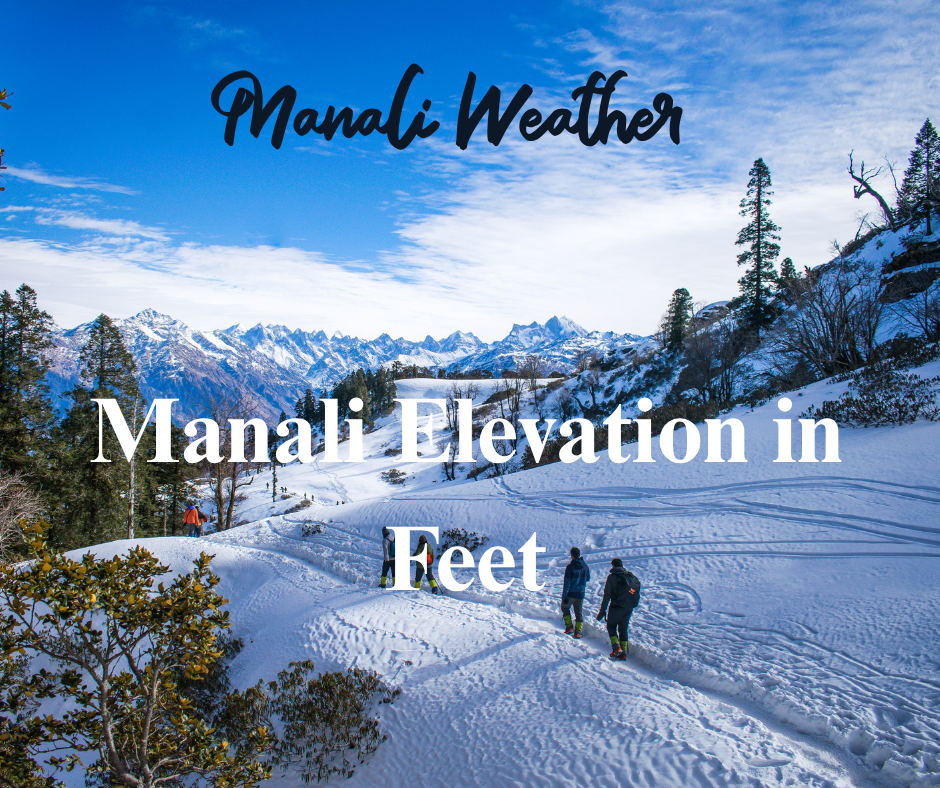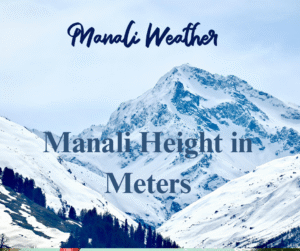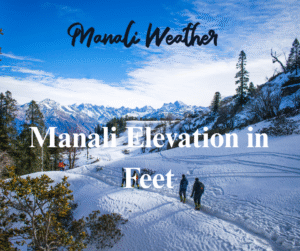Manali Elevation in Feet
Manali Elevation in Feet: A Complete Travel Guide to Heights & Himalayas
Introduction
Manali, a scenic hill station nestled in the Kullu Valley of Himachal Pradesh, is renowned for its snow-capped peaks, lush valleys, and thrilling adventure sports. One common query from travelers and trekkers is about Manali’s elevation in feet—a crucial factor that affects not only your travel experience but also the weather, altitude sickness risk, and sightseeing options.
In this guide, we’ll explore Manali’s elevation, how it influences the climate, what travelers should expect at this height, and tips for acclimatizing to high altitudes.

What is the Elevation of Manali in Feet?
Manali Elevation in Feet The elevation of Manali is approximately 6,730 feet (2,050 meters) above sea level. This places it in the category of high-altitude hill stations in India. Manali’s location at this elevation offers a cool climate year-round and attracts tourists in both summer and winter seasons.
Why Manali’s Elevation Matters to Travelers
-
Cooler Temperatures:
Manali Elevation in Feet Due to its high elevation, Manali enjoys a temperate climate. Even in the peak of summer, temperatures rarely exceed 25°C (77°F). This makes it a perfect summer escape. -
Snowfall in Winters:
At 6,730 feet, Manali often receives snowfall between December and February, especially in Solang Valley and nearby higher areas Manali Elevation in Feet. -
Health & Acclimatization:
While 6,730 feet is not dangerously high, some visitors may still experience mild altitude symptoms like shortness of breath or fatigue, Manali Elevation in Feet especially if they’re traveling to even higher places like Rohtang Pass or Leh.
Nearby Places and Their Elevations for Comparison
| Place | Elevation (Feet) | Elevation (Meters) |
|---|---|---|
| Manali | 6,730 ft | 2,050 m |
| Solang Valley | 8,400 ft | 2,560 m |
| Rohtang Pass | 13,050 ft | 3,978 m |
| Atal Tunnel (North) | 10,000 ft | 3,048 m |
| Old Manali | 6,800 ft | 2,073 m |
Knowing these elevations helps in planning your journey and managing altitude-related symptoms.
Manali’s Elevation and Its Impact on Weather
The altitude of Manali greatly influences its weather patterns:
-
Summer (March to June):
Days are pleasant and nights are cool. Temperatures range from 10°C to 25°C due to the elevation. -
Monsoon (July to September):
The region receives moderate to heavy rainfall. Landslides may occur on hilly roads due to the terrain. -
Autumn (October to November):
Crisp air, clear skies, and lower tourist crowds. Great time to explore the elevation-based beauty of the Himalayas. -
Winter (December to February):
The high altitude brings snow, especially in nearby regions like Gulaba and Rohtang. Day temperatures can drop below freezing.
Manali Elevation in Feet Travel Tips for High Elevation Destinations like Manali
-
Acclimatize Gradually:
If you’re coming from low-altitude cities like Delhi or Mumbai, take it easy on your first day. Avoid strenuous activity immediately after arrival. -
Stay Hydrated:
Dry mountain air at higher altitudes can lead to dehydration. Drink plenty of fluids. -
Pack Accordingly:
Even in summer, carry warm clothes. Temperatures can drop quickly after sunset due to Manali Elevation in Feet. -
Altitude Sickness Signs:
Watch for dizziness, nausea, or headache—especially if you’re heading to higher passes. -
Travel Insurance:
Consider policies that cover high-altitude destinations and medical emergencies.
Best Time to Visit Manali Based on Elevation
-
Summer (March–June) is perfect for sightseeing, trekking, and riverside camping. The elevation ensures cool, pleasant weather.
-
Winter (December–February) is ideal for snow lovers and skiing enthusiasts. The elevation allows regular snowfall in nearby slopes.
-
Avoid monsoon season (July–August) if you plan high-altitude treks, as landslides can make travel risky.
Adventure Activities at Manali’s Altitude
The elevation of Manali makes it an adventure hub for:
-
Paragliding at Solang Valley
-
River Rafting in the Beas River
-
Trekking to places like Bhrigu Lake and Hampta Pass
-
Skiing and Snowboarding during winter months
The high-altitude terrain ensures ideal conditions for adrenaline-packed fun!
How Manali’s Elevation Compares to Other Hill Stations
| Hill Station | Elevation in Feet |
|---|---|
| Manali | 6,730 ft |
| Shimla | 7,100 ft |
| Mussoorie | 6,600 ft |
| Darjeeling | 6,700 ft |
| Nainital | 6,837 ft |
Manali is among the higher hill stations in India, with a perfect balance of accessibility and mountain charm.
Conclusion
Understanding the elevation of Manali in feet gives you deeper insight into what to expect during your visit. Whether you’re coming for snow, scenic views, or Himalayan adventures, knowing that Manali sits at 6,730 feet above sea level helps you plan your trip better.
This high-altitude gem of Himachal Pradesh is more than just a hill station—it’s a gateway to the mighty Himalayas and all the beauty that comes with it.
Bungee Jumping in Manali Price | Bungee Jumping in Manali





